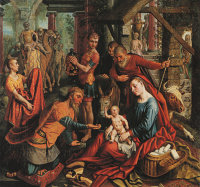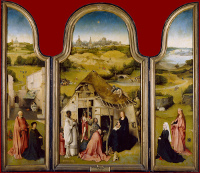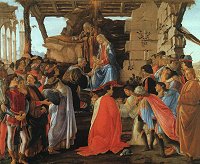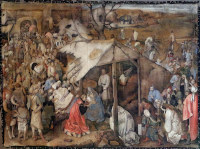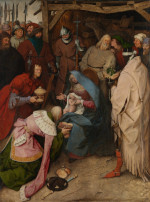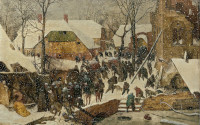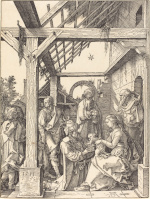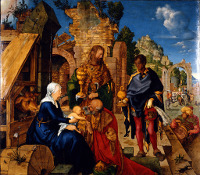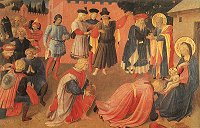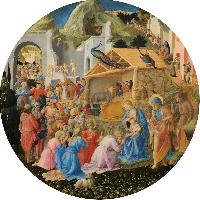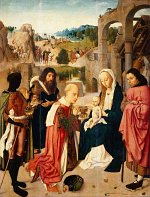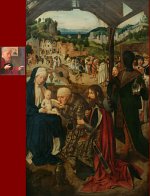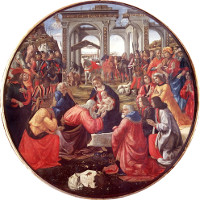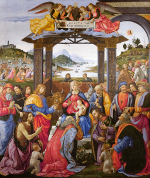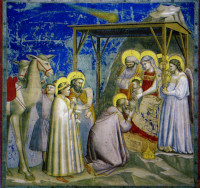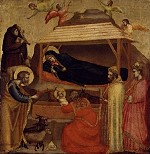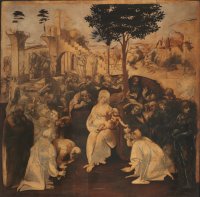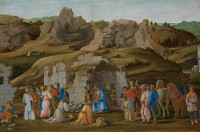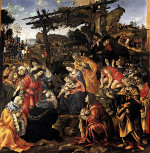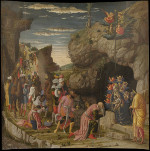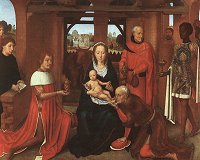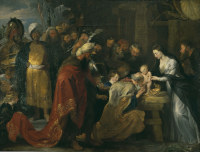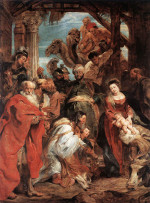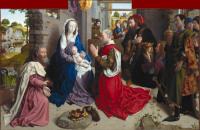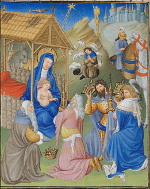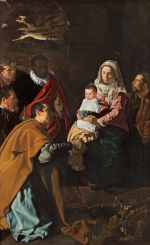The Adoration of the Magi story has inspired countless works of art. Beginning in the fourth century, representations of the Adoration of the Magi have become a tour de force in art that continues to this day. The first representations appeared in catacomb paintings and sarcophagus reliefs found throughout the Mediterranean region. By the tenth century, the Magi began to wears crowns, looking rather kingly, and overall their attire had lost its Middle Eastern look. Also, in this period, they began to be shown as the three ages of man.
Then, in the twelfth to fifteen centuries, the Magi were made to represent the three known parts of the world: Balthazar is cast as the young Moor or African; Caspar is given Asian features, while Melchior is suppose to be of European descent. From the fourteenth century onwards, the Magi have large retinues comprised of many animals and attendants and their gifts to Jesus are spectacular in nature; the attire of the Magi is now resplendent as well; and the manger scene is often replaced by a house, inn or castle.
By the fifteenth century, paintings of the scene have become large and magnificent, displaying the artist’s great skill with depictions of crowd scenes containing many people, animals and sumptuous objets de art. The paintings are sometimes done in triptychs, the two outer scenes or pendants contrasting with the middleNativity.
None other than the great Leonardo da Vinci made a version of the Adoration of the Magi. Though unfinished, the piece has been in the Uffizi Gallery in Florence since 1670. Interestingly, the scene of the painting is set among pagan ruins and Leonardo has put a self-portrait of himself in the far right of the work. The ruins could represent the Basilica of Maxentius, signifying Christianity’s victory over the pagan world of the Romans, though the basilica hadn’t been built as yet during the time of Christ.
Click each painting for a larger image and description or the artist name for additional works.
Art from From "Art in the Bible" (http://www.artbible.info/)
-
Pieter Aertsen: Adoration of the Magi
· oil on panel – c. 1560 -
Jheronimus Bosch: The Adoration of the Magi
· oil on panel – 1485-1500 -
Botticelli (Sandro Filipepi): The Adoration of the Magi
· tempera on panel – 1475 -
Pieter Bruegel the Elder: The Adoration of the Magi (Brussels)
· tempera on canvas – 1556-62 -
Pieter Bruegel the Elder: The Adoration of the Magi (London)
· oil on canvas – 1564 -
Pieter Bruegel the Elder: The Adoration of the Magi in the snow
· tempera on panel – 1567 -
Albrecht Dürer: The Adoration of the Magi (engraving)
-
Albrecht Dürer: The Adoration of the Magi (oil)
· oil on panel – 1504-05 -
Fra Angelico: The Adoration of the Magi (1433-35)
· tempera on panel – 1433-35 -
Fra Angelico: The Adoration of the Magi (1445)
· tempera on panel – ca. 1445 -
Geertgen tot Sint Jans: Adoration of the Magi (Amsterdam)
· oil on panel – c. 1490 -
Geertgen tot Sint Jans: Adoration of the Magi (Cleveland)
· oil on panel – c. 1490 -
Geertgen tot Sint Jans: Adoration of the Magi (Prague)
· oil on panel – c. 1485 -
Domenico Ghirlandaio: The Adoration of the Magi (1487)
· tempera on panel – 1487 -
Domenico Ghirlandaio: The Adoration of the Magi (1488)
· tempera on panel – 1488 -
Giotto: The Adoration of the Magi (Arena chapel)
· fresco – 1304-1306 -
Giotto: The Adoration of the Magi (Santa Croce)
· tempera on panel – ca. 1320 -
Leonardo da Vinci: The Adoration of the Magi
· oil on panel – 1481-82 -
Filippino Lippi: The Adoration of the Magi
· oil and tempera on panel – ca. 1480 -
Filippino Lippi: The Adoration of the Magi (1496)
· oil on panel – 1496 -
Andrea Mantegna: The Adoration of the Magi
· tempera on panel – c. 1461 -
Hans Memling: The Adoration of the Magi
· oil on panel – 1479 -
Peter Paul Rubens: The Adoration of the Magi (1617-18)
· oil on canvas – 1617-18 -
Peter Paul Rubens: The Adoration of the Magi (1624)
· oil on panel – 1624 -
Hugo van der Goes: Adoration of the Magi
· oil on panel – c. 1470/75 -
Van Limburg brothers: The Adoration of the Magi
· illuminated manuscript – 1408-09 -
Diego Rodriguez da Silva y Velázquez: The Adoration of the Magi
· oil on canvas – 1619 -

